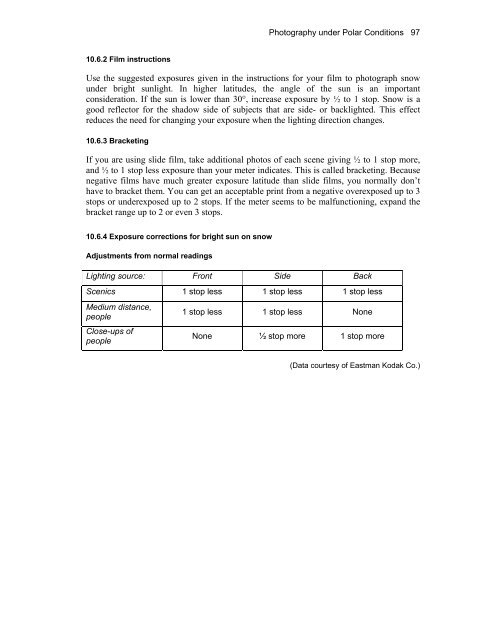Edited by Rachel Duncan 4th Edition ISBN 0-907649-91-2 London ...
Edited by Rachel Duncan 4th Edition ISBN 0-907649-91-2 London ...
Edited by Rachel Duncan 4th Edition ISBN 0-907649-91-2 London ...
You also want an ePaper? Increase the reach of your titles
YUMPU automatically turns print PDFs into web optimized ePapers that Google loves.
10.6.2 Film instructions<br />
Photography under Polar Conditions 97<br />
Use the suggested exposures given in the instructions for your film to photograph snow<br />
under bright sunlight. In higher latitudes, the angle of the sun is an important<br />
consideration. If the sun is lower than 30°, increase exposure <strong>by</strong> ½ to 1 stop. Snow is a<br />
good reflector for the shadow side of subjects that are side- or backlighted. This effect<br />
reduces the need for changing your exposure when the lighting direction changes.<br />
10.6.3 Bracketing<br />
If you are using slide film, take additional photos of each scene giving ½ to 1 stop more,<br />
and ½ to 1 stop less exposure than your meter indicates. This is called bracketing. Because<br />
negative films have much greater exposure latitude than slide films, you normally don’t<br />
have to bracket them. You can get an acceptable print from a negative overexposed up to 3<br />
stops or underexposed up to 2 stops. If the meter seems to be malfunctioning, expand the<br />
bracket range up to 2 or even 3 stops.<br />
10.6.4 Exposure corrections for bright sun on snow<br />
Adjustments from normal readings<br />
Lighting source: Front Side Back<br />
Scenics 1 stop less 1 stop less 1 stop less<br />
Medium distance,<br />
people<br />
Close-ups of<br />
people<br />
1 stop less 1 stop less None<br />
None ½ stop more 1 stop more<br />
(Data courtesy of Eastman Kodak Co.)

















